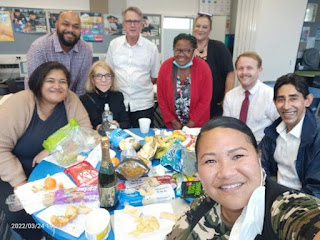LOCAL CURRICULUM: Local curriculum refers to determining your priorities and foci for learning according to your own context and shared values.
Understanding what local curriculum is was the other focus area for our department at our most recent TOD. Initially there was some understanding on what 'local curriculum' is and what it entails, there was a document that had questions that helped guide our department discussion on what it is, what practices we have in place that mirror a local curriculum and what our next steps are. Below I have inserted the questions and answers (feedback from the department) on 'local curriculum'.
 |
| English Department 2022 |
What do you think is meant by the term ‘local curriculum’?
- Identifying local needs and creating pathways.
- A local curriculum is adapting the New Zealand Curriculum to your School and its Learners
- A curriculum that takes the needs of the community into consideration.
- A curriculum that is connected, relevant and mirrors the school community
- ‘Personalizing’ the curriculum to suit our place.
- Shares the values of the NZC.
- It refers to a curriculum that reflects the histories, experiences, cultures, languages, businesses, interests etc. of our community, whānau, ākonga, and mana whenua.
- Historical + cultural narratives that connect to place
- Integrating and celebrating different cultures
- Mana whenua kōrero, past and present.
- East-side G.I.
- Adapting to our Learner’s, their backgrounds, experiences etc.
- Tereora Academy
- Project RISE
- SAS
- Police Academy
- TC Driving Academy
- Akomanga Kaihanga
In what ways does your local curriculum build on the strengths, needs, and interests of your people?
- Parent meetings
- Involving students' families through conversation (meetings, keeping them well informed via different platforms - Email, Text, Letters home, Facebook, Instagram etc.)
- School vision: Tamaki College is a vibrant engaged learning community, accepting challenges in the wairua of excellence, integrity, resilience and respect. Together we weave our talents, strengths and values to harness opportunities with commitment and innovation.
- Engaging
- Vibrant
- Innovative
- NZC Vision(The vision is for young people to be confident, connected, actively involved, lifelong learners).
- Cultural norms and traditional values and parental expectations of their children.
- Media cultural exposure and social media connections
How well do you know the aspirations of your students and whānau? What could you do to know them more deeply?
- I know some of their aspirations but not all - I do wonder if their family know what their aspirations are though, like do they talk about this with them at home
How can you provide rich opportunities for learning based on your students’ strengths, identities, and priorities?
- Allowing students to express themselves in their own language, beliefs, styles of doing things and questioning. Also by encouraging them to be creators of their own destinies and aspirations.
How is the Treaty of Waitangi curriculum principle reflected in your school’s vision and development of local curriculum?
What do you know about the history of your school community or local area?- Making the bicultural foundations evident in the school policies and day-to-day undertakings and learning of our students’ everyday experiences.
- I do not know much or enough
- Besides living within the community and being an alumna, I probably should know more than I do, if that makes sense
- Tamaki College was planned to be a school for boys and girls once it reached the roll of 1400 students
- It is connected to the War and hence the road names of fallen soldiers… I think.
- It’s catchment area is from the primary schools around and about such that TC has become the ‘mother’ school.
- It is not represented in our school currently, however there are conversations happening with Social Sciences and other departments in our kura with mana whenua spokesperson Matua Harley Wade about histories and kōrero, past and present.
- It isn’t sadly.
- First, we need to acknowledge that there is diversity in the ‘body of knowledge’ within our Māori community.
- We have been sharing the pepeha of Tainui. Ngāti Pāoa have their own pepeha.
- Stories are different to histories
How could you develop a stronger place-based curriculum and what areas of the national curriculum might be developed through this focus?
- Have a change package where Maori people do not feel the shame imposed upon them.
- Make Maori more visible to the students and community.
- Let the students write about their experiences e.g celebrating a wedding, going to a Tangi, etc.
- Discerning the truth about the different ways of being Maori.
- Deal with the diversity of Maori people
- ‘Local’ is the students + community
- Understand the history of the mana whenua
- Respecting the genealogies, upbringing of our students
- o be invested in protecting the Maori stories and how we intend to portray them.
- The stories have to come from the local community to make sense of Maori learning
- Encourage a sense of pride - people who understand the history of the Maori and other cultural groups
- The elders in the community
The discussions that we had as a department around local curriculum was both affirming but confronting at the same time. For our department, what we took away from the discussion is that a local curriculum is so much more than having a learning program that is relevant and reflective of our community. It is a curriculum that acknowledges, celebrates, values and honors the local iwi and their stories. It is a curriculum that is culturally and socially responsive to the people in the community. A curriculum that is shared across all learning areas with one goal in mind. We understand that it is a journey and the journey requires a complete mindset shift across the learning areas - the key stakeholders.




No comments:
Post a Comment